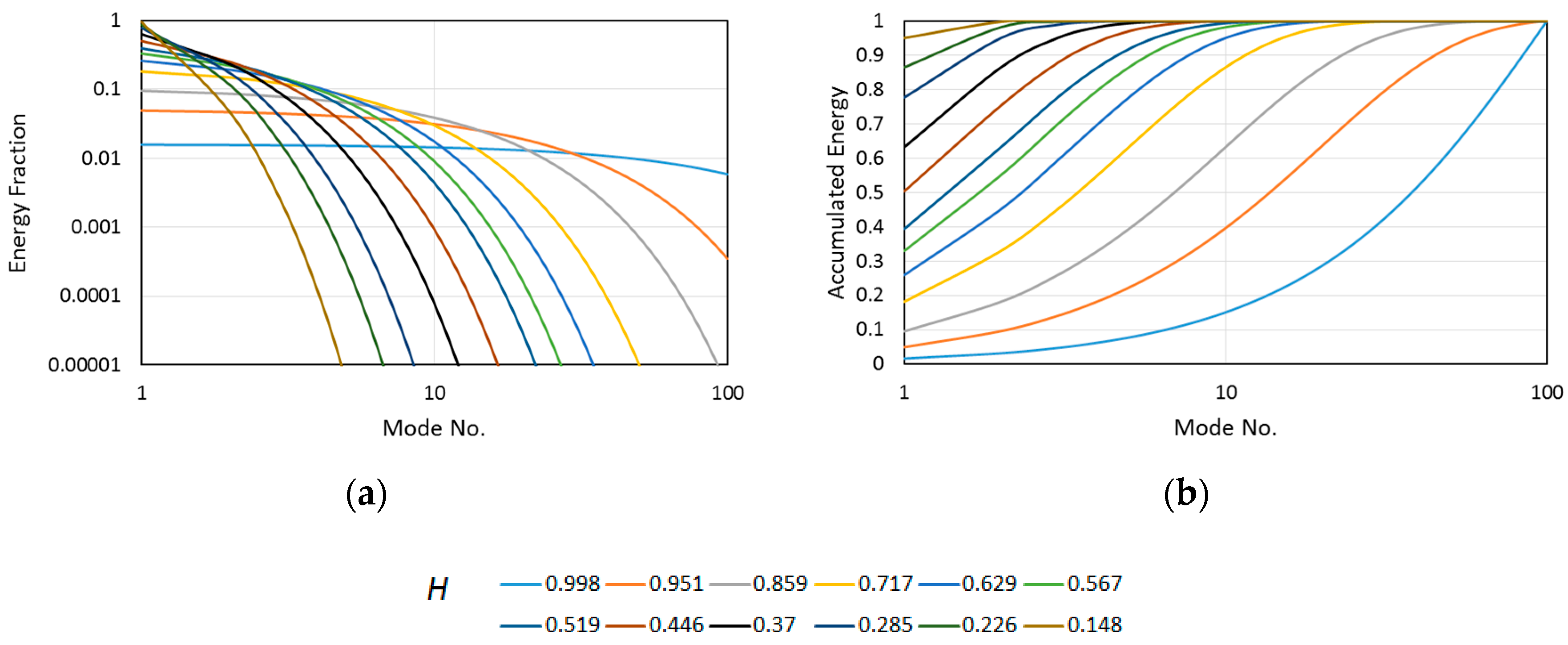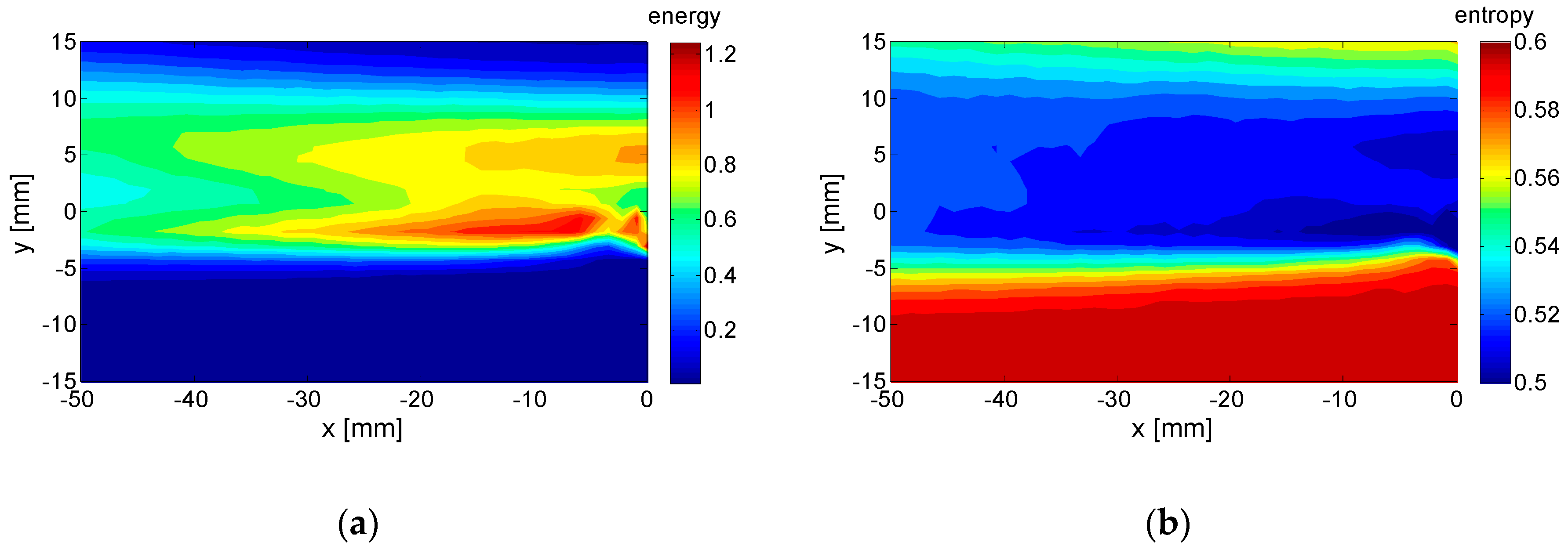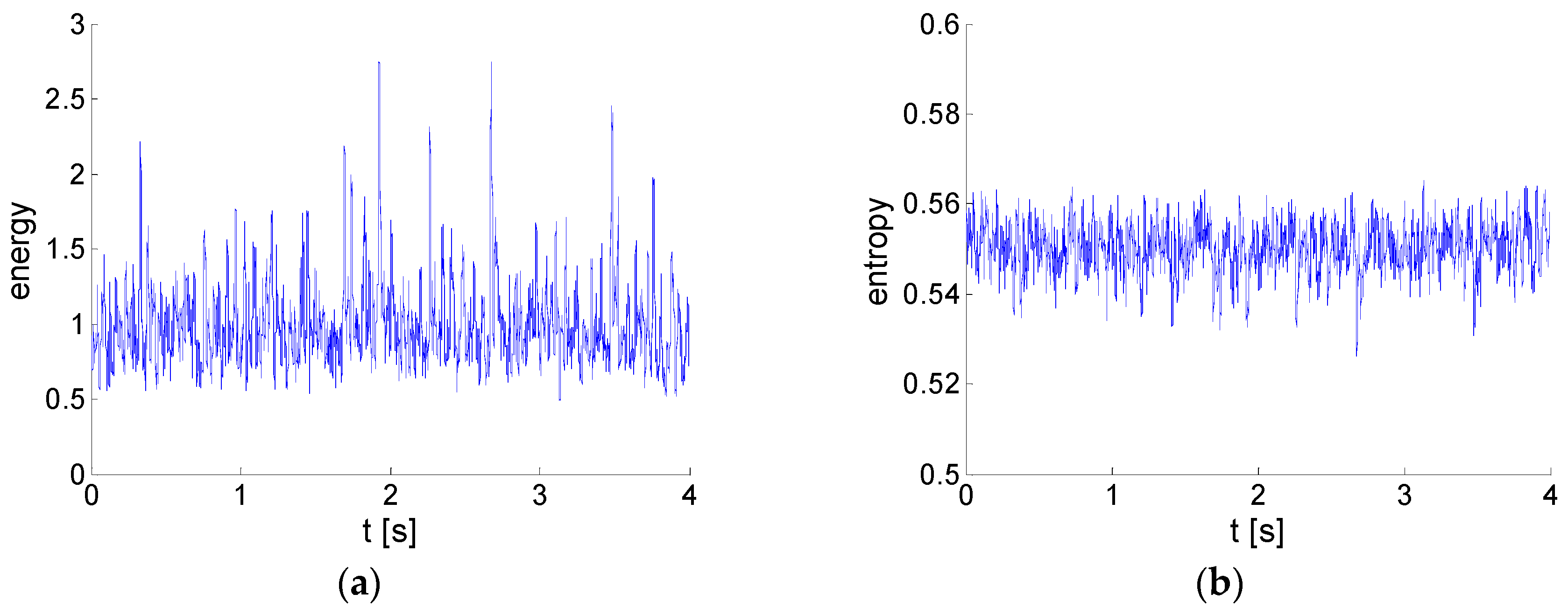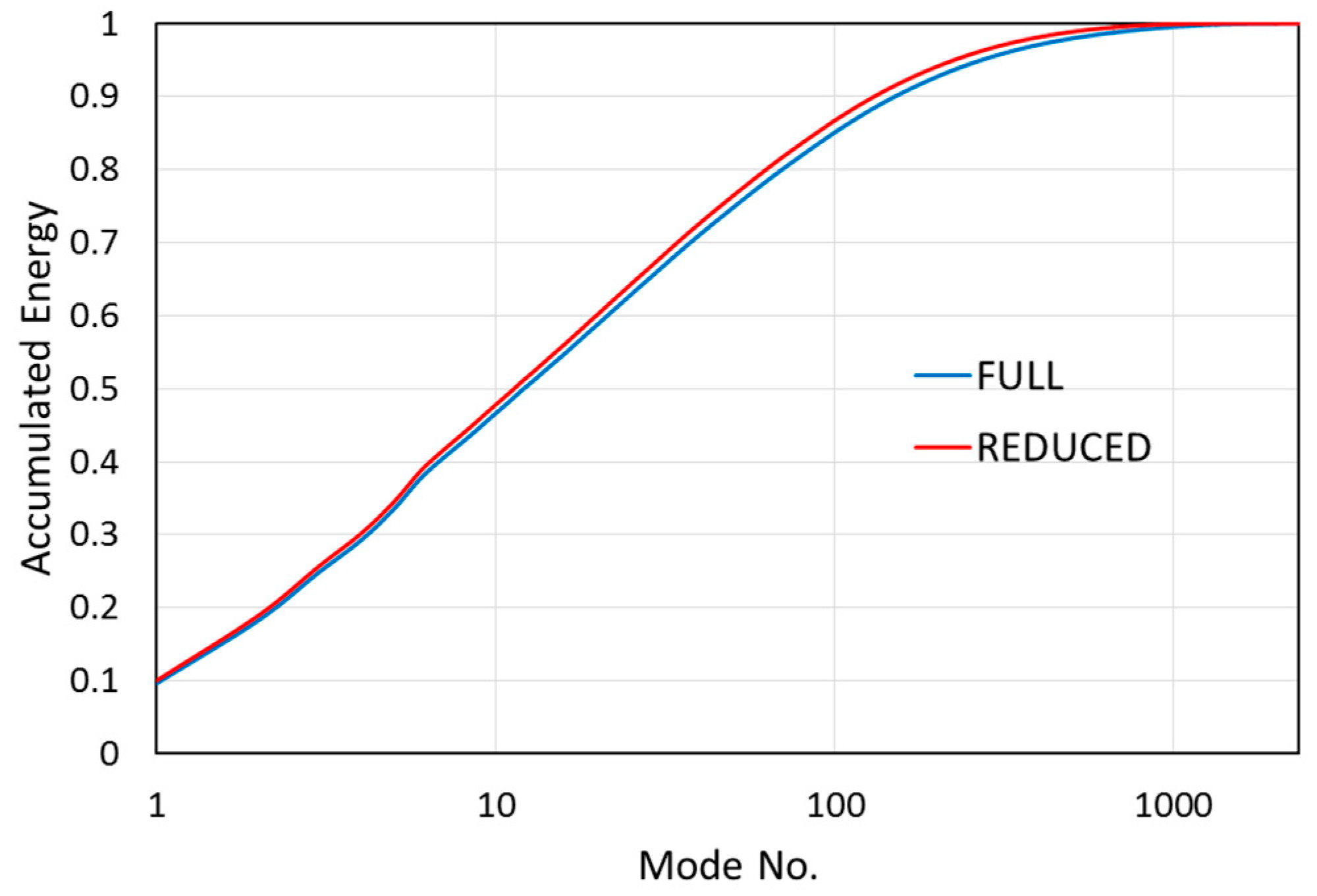Energy and Entropy in Turbulence Decompositions
Abstract
1. Introduction
2. Historical Notes
3. Decomposition Methods
3.1. Definition of Kinetic Energy
3.2. Proper Orthogonal Decomposition
3.3. Snapshot POD
3.4. Bi-Orthogonal Decomposition
4. Energy and Entropy
5. Energy and Entropy Discussion
6. Example
6.1. Experimental Set-Up
6.2. Results and Discussion
7. Conclusions
Funding
Acknowledgments
Conflicts of Interest
References
- Pope, S.B. Turbulent Flows; Cambridge University Press: Cambridge, UK, 2000. [Google Scholar]
- Lumley, J.L. The structure of inhomogeneous turbulent flows. In Atmospheric Turbulence and Radio Wave Propagation; Tatarsky, V.I., Yaglom, A.M., Eds.; Nauka: Moskva, Russia, 1967; pp. 166–178. [Google Scholar]
- Aubry, N.; Guyonnet, R.; Lima, R. Spatiotemporal Analysis of Complex Signals: Theory and Applications. J. Stat. Phys. 1991, 64, 683–739. [Google Scholar] [CrossRef]
- Arnold, L. Stochastic Differential Equations: Theory and Applications; Wiley Sons: Hoboken, NJ, USA, 1974. [Google Scholar]
- Bendat, J.S.; Piersol, A.G. Random Data: Analysis and Measurement Procedures; Wiley Sons: Hoboken, NJ, USA, 2011. [Google Scholar]
- Pearson, K. On lines and planes of closest fit to systems of points in space. Lond. Edinb. Dublin Phil. Mag. J. Sci. 1901, 2, 559–572. [Google Scholar] [CrossRef]
- Hotelling, H. Analysis of a complex of statistical variables into principal components. J. Educ. Psychol. 1933, 24, 417–441. [Google Scholar] [CrossRef]
- Kosambi, D.D. Statistics in function space. J. Ind. Math. Soc. 1943, 7, 76–88. [Google Scholar]
- Loève, M. Nouvelles classes de lois limites. Bull. Soc. Math. Fr. 1945, 73, 107–126. [Google Scholar] [CrossRef]
- Karhunen, K. Zur spektraltheorie stochastischer prozesse. Ann. Acad. Sci. Fenn. AI 1946, 34, 3–7. [Google Scholar]
- Pougachev, V.S. The general theory of correlation of random functions. Izv. Akad. Nauk SSSR Ser. Mat. 1953, 17, 401–420. [Google Scholar]
- Obukbov, A.M. Statistical description of continuous fields. Tr. Geophys. Int. Akad. Nauk. SSSR 1954, 24, 3–42. [Google Scholar]
- Tropea, C.; Yarin, A.L.; Foss, J.F. (Eds.) Handbook of Experimental Fluid Mechanics; Springer: Berlin, Germany, 2007. [Google Scholar]
- Adrian, R.J.; Christensen, K.T.; Liu, Z.C. Analysis and interpretation of instantaneous turbulent velocity fields. Exp. Fluids 2000, 29, 275–290. [Google Scholar] [CrossRef]
- Lumley, J.L. Coherent Structures in Turbulence, Transition and Turbulence; Meyer, R.E., Ed.; Academic Press: New York, NY, USA, 1981; pp. 215–242. [Google Scholar]
- Solari, G.; Carassale, L.; Tubino, F. Proper orthogonal decomposition in wind engineering. Part 1: A state-of-the-art and some prospects. Wind Struct. 2007, 10, 153–176. [Google Scholar] [CrossRef]
- Grinberg, L.; Yakhot, A.; Karniadakis, G.E. Analyzing Transient Turbulence in a Stenosed Carotid Artery by Proper Orthogonal Decomposition. Ann. Biomed. Eng. 2009, 37, 2200–2217. [Google Scholar] [CrossRef] [PubMed]
- Azeez, M.F.A.; Vakakis, A.F. Proper orthogonal decomposition (POD) of a class of vibroimpact oscillations. J. Sound Vib. 2001, 240, 859–889. [Google Scholar] [CrossRef]
- Boree, J. Extended proper orthogonal decomposition: A tool to analyse correlated events in turbulent flows. Exp. Fluids 2003, 35, 188–192. [Google Scholar] [CrossRef]
- Sieber, M.; Paschereit, C.O.; Oberleithner, K. Spectral proper orthogonal decomposition. J. Fluid Mech. 2016, 792, 798–828. [Google Scholar] [CrossRef]
- Willcox, K.; Peraire, J. Balanced Model Reduction via the Proper Orthogonal Decomposition. AIAA J. 2002, 40, 2323–2330. [Google Scholar] [CrossRef]
- Berkooz, G.; Elezgaray, J.; Holmes, P.; Lumley, J.; Poje, A. The Proper Orthogonal Decomposition, wavelets and modal approaches to the dynamics of coherent structures. Appl. Sci. Res. 1994, 53, 321–338. [Google Scholar] [CrossRef]
- Kellnerova, R.; Kukacka, L.; Jurcakova, K.; Uruba, V.; Janour, Z. Comparison of wavelet analysis with velocity derivatives for detection of shear layer and vortices inside a turbulent boundary layer. J. Phys. Conf. Ser. 2011, 18, 062012. [Google Scholar] [CrossRef]
- Chapelle, D.; Gariah, A.; Sainte-Marie, J. Galerkin approximation with proper orthogonal decomposition: New error estimates and illustrative examples. Math. Model. Numer. Anal. 2012, 46, 731–757. [Google Scholar] [CrossRef]
- Stankiewicz, W.; Morzyński, M.; Noack, B.R.; Tadmor, G. Reduced order Galerkin models of flow around NACA-0012 airfoil. Math. Model. Anal. 2008, 13, 113–122. [Google Scholar] [CrossRef]
- Schmid, P.J. Dynamic mode decomposition of numerical and experimental data. J. Fluid Mech. 2010, 656, 5–28. [Google Scholar] [CrossRef]
- Uruba, V. Near Wake Dynamics around a Vibrating Airfoil by Means of PIV and Oscillation Pattern Decomposition at Reynolds Number of 65 000. J. Fluids Struct. 2015, 55, 372–383. [Google Scholar] [CrossRef]
- Uruba, V. Decomposition methods in turbulence research. EPJ Web Conf. 2012, 25, 01095. [Google Scholar] [CrossRef]
- Sirovich, L. Turbulence and the dynamics of coherent structures. Quart. Appl. Math. 1987, 45, 561–590. [Google Scholar] [CrossRef]
- Shannon, C.E. A mathematical theory of communication. Bell Syst. Tech. J. 1948, 27, 379–423. [Google Scholar] [CrossRef]
- Uruba, V.; Procházka, P.; Skála, V. On the structure of the boundary layer under adverse pressure gradient on an inclined plate. J. Phys. Conf. Ser. 2018, 1101, 012047. [Google Scholar] [CrossRef]















© 2019 by the author. Licensee MDPI, Basel, Switzerland. This article is an open access article distributed under the terms and conditions of the Creative Commons Attribution (CC BY) license (http://creativecommons.org/licenses/by/4.0/).
Share and Cite
Uruba, V. Energy and Entropy in Turbulence Decompositions. Entropy 2019, 21, 124. https://doi.org/10.3390/e21020124
Uruba V. Energy and Entropy in Turbulence Decompositions. Entropy. 2019; 21(2):124. https://doi.org/10.3390/e21020124
Chicago/Turabian StyleUruba, Václav. 2019. "Energy and Entropy in Turbulence Decompositions" Entropy 21, no. 2: 124. https://doi.org/10.3390/e21020124
APA StyleUruba, V. (2019). Energy and Entropy in Turbulence Decompositions. Entropy, 21(2), 124. https://doi.org/10.3390/e21020124




